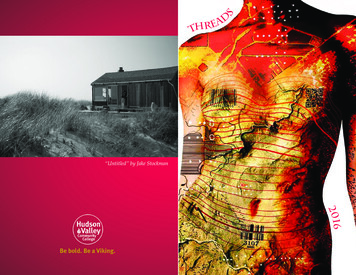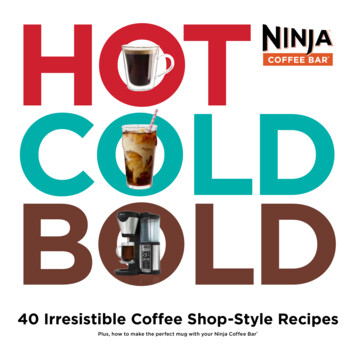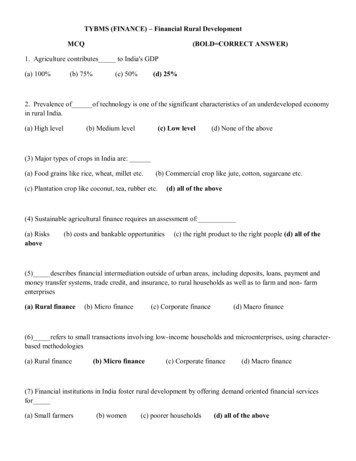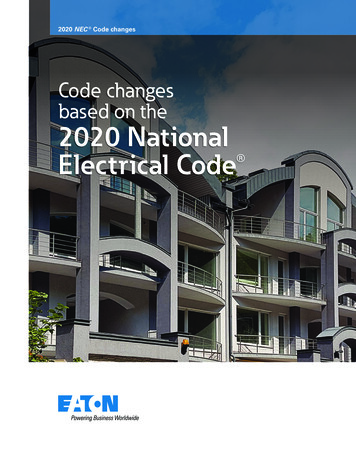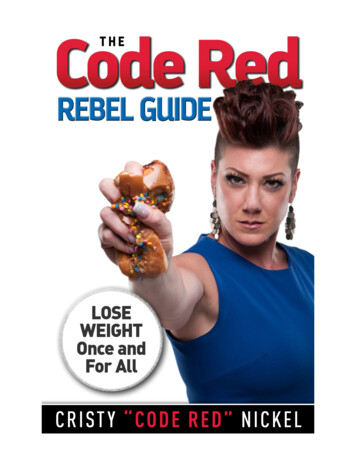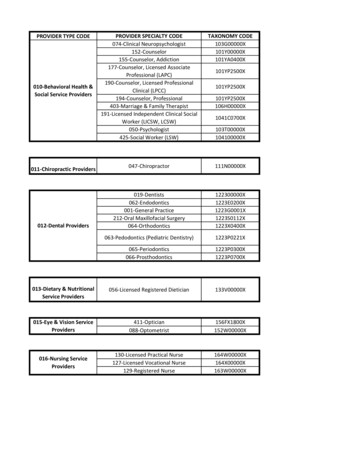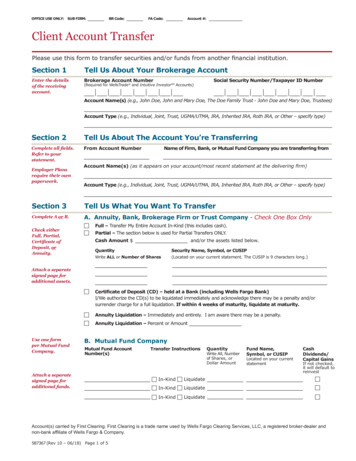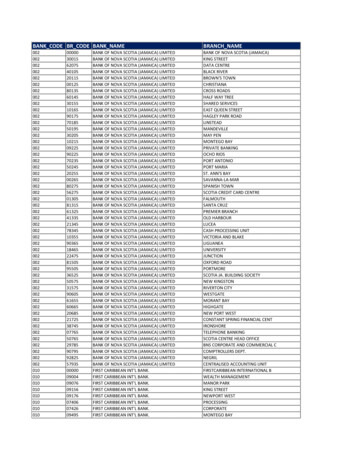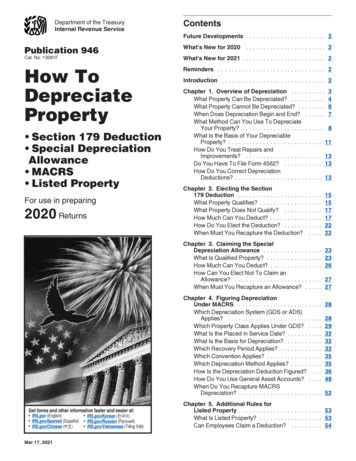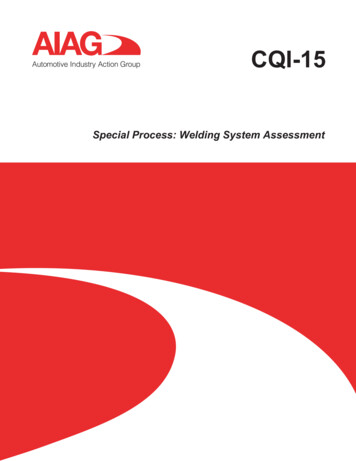
Transcription
CQI-15Special Process: Welding System Assessment
CQI-15Special Process: Welding System AssessmentVersion 1 Issued 3/10ABOUT AIAGationPurpose StatementFounded in 1982, AIAG is a globally recognized organization where OEMs and suppliers unite to addressand resolve issues affecting the worldwide automotive supply chain. AIAG’s goals are to reduce cost andcomplexity through collaboration; improve product quality, health, safety and the environment; andoptimize speed to market throughout the supply chain.GIn ente errn aal l MU otse orO sCnl oyrporAIAG OrganizationAIAG is made up of a board of directors, an executive director, executives on loan from membercompanies, associate directors, a full-time staff, and volunteers serving on project teams. Directors,department managers, and program managers plan, direct and coordinate the association’s activitiesunder the direction of the executive director.AIAG ProjectsVolunteer committees focus on business processes or supporting technologies and methodologies. Theyconduct research and develop, publish, and provide training on standards, conventions, standardbusiness practices, white papers, and guidelines in the areas of automatic identification, CAD/CAM,EDI/electronic commerce, continuous quality improvement, health focus, materials and projectmanagement, occupational health & safety, returnable containers and packaging systems,transportation/customs and truck & heavy equipment.AIAG PUBLICATIONSAn AIAG publication reflects a consensus of those substantially concerned with its scope and provisions. AnAIAG publication is intended as a guide to aid the manufacturer, the consumer and the general public. Theexistence of an AIAG publication does not in any respect preclude anyone from manufacturing, marketing,purchasing, or using products, processes, or procedures not conforming to the publication.CAUTIONARY NOTICEAIAG publications are subject to periodic review and users are cautioned to obtain the latest editions.MAINTENANCE PROCEDUREofRecognizing that this AIAG publication may not cover all circumstances, AIAG has established a maintenanceprocedure. Please refer to the Maintenance Request Form at the back of this document to submit a request.Published by:Automotive Industry Action Group26200 Lahser Road, Suite 200Southfield, Michigan 48033Phone: (248) 358-3570 Fax: (248) 358-3253tyAPPROVAL STATUSoperThe AIAG Quality Steering Committee and designated stakeholders approved this document for publication inMarch 2010.AIAG COPYRIGHT AND TRADEMARK NOTICE:Pr 2010 Automotive Industry Action Group, except that copyright is not claimed as to any part of an original work prepared by a U.S.or state government officer or employee as part of the person’s official duties.Except as noted above, all rights are reserved by AIAG and no part of these materials may be reproduced, reprinted, stored in aretrieval system, or transmitted, in any form or by any means, electronic, photocopying, recording, or otherwise, without the priorwritten permission of Automotive Industry Action Group. Copyright infringement is a violation of federal law subject to criminal andcivil penalties.AIAG and Automotive Industry Action Group are registered service marks of the Automotive Industry Action Group. AutomotiveIndustry Action Group makes no claim to any trademark of a third party. Trademarks of third parties included in these materials arethe property of their respective owners. 2010 Automotive Industry Action GroupISBN 978 1 60534 208 5-1-
CQI-15Special Process: Welding System AssessmentPropertyofGIn ente errn aal l MU otse orO sCnl oyrporationVersion 1 Issued 3/10-2-
CQI-15Special Process: Welding System AssessmentVersion 1 Issued 3/10FOREWORDationAutomotive Industry Action Group (AIAG) committees are made up of volunteers from membercompanies in the automotive industry. The work of preparing process audits is done by AIAG technicalcommittees.GIn ente errn aal l MU otse orO sCnl oyrporThe main task of technical committees is to prepare Automotive Standards and System Requirements.Draft documents adopted by the technical committees are circulated to the Steering Committee for reviewand consensus approval. Publication of the documents requires approval by the Quality SteeringCommittee.The Quality Steering Committee would like to acknowledge and thank the following individuals and theircompanies who have contributed time and effort to the development of this document.ACKNOWLEDGEMENTSCore Members:Chrysler Group LLCGilbert ChrostowskiTRW AutomotiveVirender ChoudhriDelphi CorporationThomas LopiccoloGeneral Motors CompanyNeal McMichaelFord Motor CompanyCarl OcchialiniThe Lincoln Electric CompanyVeronica SebaldToyota Motor Engineering & Manufacturing, North AmericaRyan TurnwaldHonda of America Manufacturing, Inc.ofJoseph BeckhamNexteer AutomotivePropertyDave Willig-3-
CQI-15Special Process: Welding System AssessmentVersion 1 Issued 3/10TABLE OF CONTENTSnABOUT AIAG .1atioFOREWORD .3ACKNOWLEDGEMENTS .3TABLE OF CONTENTS .4GIn ente errn aal l MU otse orO sCnl oyrporINTRODUCTION .5GENERAL .5PROCESS APPROACH .5WELDING SYSTEM ASSESSMENT GOALS .5ASSESSMENT PROCESS .5ASSESSOR QUALIFICATIONS .6OTHER REQUIREMENTS .61 SCOPE.71.1 GENERAL .71.2 APPLICATION .71.3 REFERENCE .82 THE WELDING SYSTEM ASSESSMENT PROCEDURE .93 SPECIAL PROCESS: WELDING ASSESSMENT .10APPENDIX A – PROCESS TABLES.31PropertyofGLOSSARY .49-4-
CQI-15Special Process: Welding System AssessmentVersion 1 Issued 3/10INTRODUCTIONnGeneralatioThe work of preparing CQI-15: Special Process: Welding System Assessment (WSA) was carried outthrough the AIAG Welding Work Group. These welding requirements are complementary to customerand product standards.GIn ente errn aal l MU otse orO sCnl oyrporThe WSA can be used to assess an organization’s ability to meet the requirements in this assessment, aswell as customer, regulatory, and the organization’s own requirements. The WSA can also be usedbetween an organization and its suppliers.In the WSA, the word “shall” indicates a requirement for purposes of the self assessment. Failure to meetthe requirements results in an assessment that is either “Not Satisfactory” or “Needs Immediate Action.”The word “should” indicates a recommendation. Where the term “such as” is used, any suggestions givenare for guidance only.Process ApproachThe WSA supports the automotive process approach as described in ISO/TS 16949.Welding System Assessment GoalsThe goal of the WSA is the development of a welding management system that provides for continualimprovement, emphasizing defect prevention and the reduction of variation and waste in the supply chain.The WSA, coupled with an internationally recognized quality management system and applicablecustomer-specific requirements, defines the fundamental requirements for welding management systems.ofThe WSA is intended to provide a common approach to a welding management system for automotiveproduction and service part organizations.tyAssessment ProcessProperOngoing assessments shall be conducted annually, unless otherwise specified by the customer, to reexamine the continuing compliance with the WSA. Each assessment shall include a review of theorganization’s systems using the WSA. Successive Job Audits (Section 6.0 of this document) shallsample parts from different automotive component manufacturers that require compliance to the WSAdocument.The assessment shall use the process approach to auditing as identified by the requirements of ISO/TS16949.-5-
CQI-15Special Process: Welding System AssessmentVersion 1 Issued 3/10atioAssessor(s) shall have the following specific experience to conduct the WELDING SYSTEMASSESSMENT:nAssessor Qualifications1. Be an experienced quality management system (QMS) internal auditor (for example, latest edition ofISO/TS 16949, ISO 9001)GIn ente errn aal l MU otse orO sCnl oyrpor2. Assessor shall possess welding knowledge. Evidence shall include a minimum of 5 years experience inwelding or a combination of formal education in welding and welding experience totaling a minimum of5 years3. Assessor shall possess knowledge of and be familiar with the application of automotive quality coretools including statistical process control, measurement systems analysis, part approval, failure mode andeffects analysis, and advanced quality planning.Note: If more than one assessor is required to meet the abovequalifications, the lead assessor shall be the person meeting therequirements in item #1.Other RequirementsPropertyofThe organization shall keep records as evidence of compliance to the requirements identified in the WSA,as well as all appropriate action plans to address any unsatisfactory ratings. These records shall be readilyavailable for review by any customer requiring compliance to the requirements within this document.-6-
CQI-15Special Process: Welding System AssessmentVersion 1 Issued 3/101 SCOPEn1.1 General demonstrate ability to consistently provide product that meets customer andapplicable regulatory requirements, andenhance customer satisfaction through the effective application of the system,including processes for continual improvement of the system.GIn ente errn aal l MU otse orO sCnl oyrpor atioThis document specifies process requirements for an organization or its suppliers performing applicablewelding, who need to:The Welding System Assessment is applicable to sites where customer-specified parts for productionand/or service are processed throughout the automotive supply chain.1.2 ApplicationAll requirements of the WSA are generic and are intended to be applicable to all organizations performingthe welding operations addressed in this document, regardless of type, size, and product.Note: Four Process Tables have been developed and the appropriate table(s) is to bereferenced during the assessment. The Process Tables are specific to welding processesas noted below:Process Table A - Arc WeldingopertyofArc Stud/Fastener WeldingFlux-Cored Arc WeldingGas Metal Arc weldingSubmerged Arc WeldingShielded Metal Arc WeldingPlasma Arc WeldingGas Tungsten Arc WeldingGas Metal Arc Braze WeldingProcess Table B - Resistance WeldingPrResistance Spot WeldingProjection WeldingResistance Seam WeldingHigh-Frequency Seam WeldingInduction Seam WeldingMash Seam WeldingFlash Welding-7-
CQI-15Special Process: Welding System AssessmentVersion 1 Issued 3/10Process Table C - Laser WeldingProcess Table D - Solid State WeldingGIn ente errn aal l MU otse orO sCnl oyrporInertia Friction WeldingDirect Drive Friction WeldingFriction Stir WeldingFlash Butt WeldingResistance Butt WeldingUltrasonic WeldingationNd YAGCO2DIODEWire FedThese Process Tables contain requirements for:1.Management Responsibility & Quality Planning2.Floor and Material Handling Responsibility3.Equipment / Facilities/Controls4.Tooling/Fixturing5.Process Controls and Confirmation6.Essential VariablesThe Process Tables specify the tolerances of process parameters and the frequencies for checking processcontrol parameters and parts. The Requirements and Guidance in the WSA form will notify the assessorwhen to refer to the Process Tables.of1.3 ReferenceopertyThe following standards are used as reference material. There are other reference materials that containmore information, however, the list is not meant to be inclusive. T
AWS A3.0 Standard Welding Terms and Definitions www.aws.org ; AWS C7.2 Recommended Practices for Laser Beam and Welding ; www.aws.org . Property of General Motors Corporation Internal Use Only - 9 - CQI-15. Special Process: Welding System Assessment . Version 1 Issued 3/10. 2 THE WELDING SYSTEM ASSESSMENT PROCEDURE . 1. Obtain current copy of . CQI-15 Special Process: Welding
